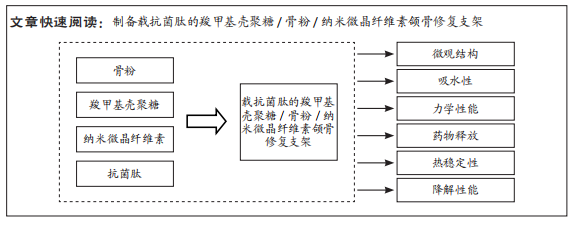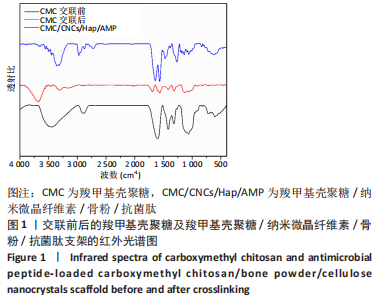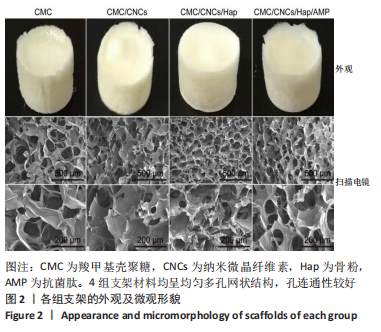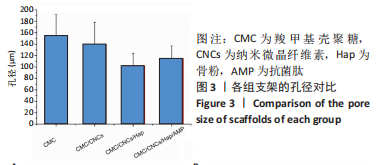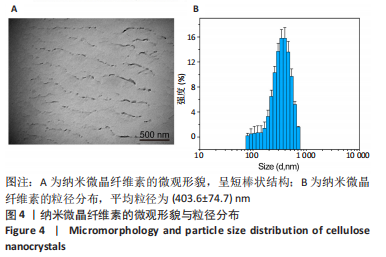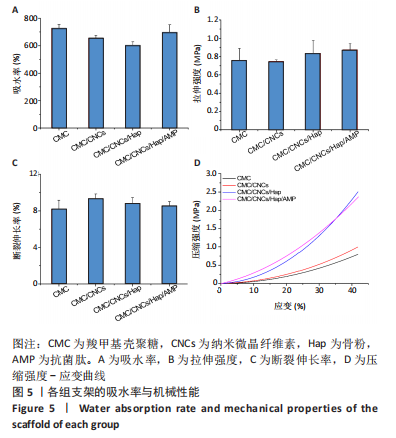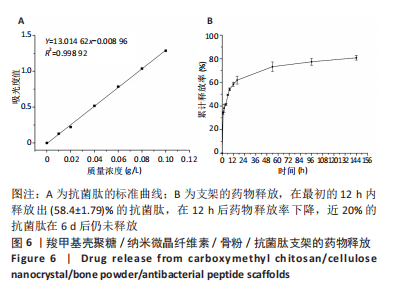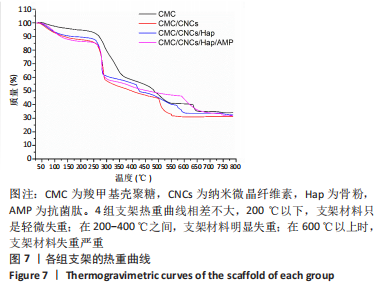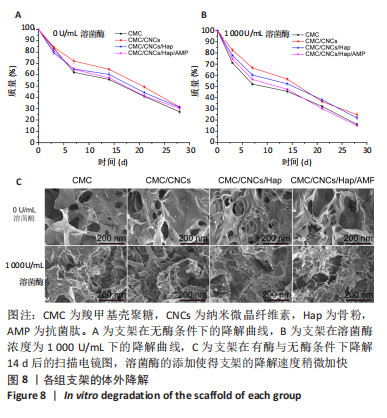[1] PACELLI S, BASU S, WHITLOW J, et al. Strategies to develop endogenous stem cell-recruiting bioactive materials for tissue repair and regeneration. Adv Drug Deliv Rev. 2017;120:50-70.
[2] YU X, TANG X, GOHIL SV, et al. Biomaterials for bone regenerative engineering. Adv Healthc Mater. 2015;4(9):1268-1285.
[3] KHOURY F, HANSER T. Mandibular Bone Block Harvesting from the Retromolar Region: A 10-Year Prospective Clinical Study. Int J Oral Maxillofac Implants. 2015;30(3):688-697.
[4] SAKKAS A, WILDE F, HEUFELDER M, et al. Autonomic bone grafts in oralimplantology-is it still a “gold standard”? A consecutive review of 279 patients with 456 clinical procedures. Int J Implant Dent. 2017; 3(1):1-17.
[5] YUNOS DM, BRETCANU O, BOCCACCINI AR. Polymer bioceramic composites for tissue engineering scaffolds. J Mater Sci. 2008;43(13): 4433-4442.
[6] FU Q, SAIZ E, TOMSIA AP. Bioinspired strong and highly porous glass scaffolds. Adv Funct Mater. 2011;21(6):1058-1063.
[7] 高文伟,孙丽莹,张泽天,等.生物质基含硅骨修复复合支架材料的制备、特性及评价[J].化工进展,2019,38(10):4595-4605.
[8] BORDEA IR, CANDREA S, ALEXESCU GT, et al. Nano-hydroxyapatite use in dentistry: a systematic review. Drug Metab Rev. 2020;52(2):319-332.
[9] HABRAKEN W, HABIBOVIC P, EPPLE M, et al. Calcium phosphates in biomedical applications: materials for the future? Mater Today. 2016; 19(2):69-87.
[10] 仇旭童,饶晨煜,李婷,等.骨组织工程中纳米羟基磷灰石的仿生合成研究进展[J].四川大学学报,2021,52(3):1-7.
[11] YOSHIKAWA H, TAMAI N, MURASE T, et al.Interconnected porous hydroxyapatite ceramics for bone tissue engineering. J R Soc Interface. 2009;6(3):341-348.
[12] EPPLE M. Review of potential health risks associated with nanoscopic calcium phosphate. Acta Biomater. 2018;77:1-14.
[13] MUZZARELLI RA. Chitins and chitosans for the repair of wounded skin, nerve,cartilage and bone. Carbohydr Polym. 2009;76(2):167-182.
[14] WANG G, LU G, QIANG A, et al. Preparation of cross-linked carboxymethyl chitosan for repairing sciatic nerve injury in rats. Biotechnol Lett. 2010;32(1):59-66.
[15] SLAVCHOV RI, Novev JK. Surface tension of concentrated electrolyte solutions. J Colloid Interf Sci. 2012;387(1):234-243.
[16] LIU X, MILLER AL, PARK S, et al. Functionalized carbon nanotube and graphene oxide embedded electrically conductive hydrogelsynergistically stimulates nerve cell differentiation. ACS Appl Mater Interfaces. 2017;9(17):14677-14690.
[17] GUO J, LIU J, QIE H, et al. Efficient synthesis strategy of folate-modified carboxymethyl chitosan (FCMC)/CaCO3 hybrid nanospheres and their drug-carrying and sustained release properties. J Biomater Sci Polym Ed. 2021;32(6):799-812.
[18] 韩冬琳,亓洪昭,赵瑾,等.增强纳米药物载体肿瘤内渗透分布的研究进展[J].化学进展,2016,28(9):1397-1405.
[19] LIN CC, LIN CW. Preparation of N, O-carboxymethyl chitosan nanoparticles as an insulin carrier. Drug Deliv. 2009;16(8):458-464.
[20] DE TULLIO I, CAPUTI S, PERFETTI G, et al. A human clinical and histomorphometrical study on dDifferent resorbable and nonResorbable bone substitutes used in post-eExtractive sites. Materials (Basel). 2019;12(15):2408.
[21] LI Z, DU T, RUAN C, et al. Bioinspired mineralized collagen scaffolds for bone tissue engineering. Bioact Mater. 2021;6(5):1491-1511.
[22] 孙溪饶,包佳昕,王程越.壳聚糖/矿化胶原多孔支架构建及体外成骨分化与生物相容性[J].中国组织工程研究,2022,26(34):5498-5503.
[23] NIZAN N, ZULKIFLI FH. Reinforcement of hydroxyethyl cellulose/poly (vinyl alcohol) with cellulose nanocrystal as a bone tissue engineering scaffold. J Polym Res. 2020;27(6):1-9.
[24] SULAIMAN S, MOKHTAR MN, NAIM MN, et al. Penghasilan nano-gentian selulosa (CNF) diperolehi daripada gentian kulit kenaf dan potensinya sebagai penyokong pemegunan enzim. Malay J Anal Sci. 2016;20:309-317.
[25] DAVOUDPOUR Y, HOSSAIN MS, ABDUL KHALIL HPS, et al. Optimization of high pressure homogenization parameters for the isolation of cellulosic nanofifibers using response surface methodology. Ind Crop Prod. 2015;74:381-387.
[26] KAZEMZADEH-NARBAT M, WANG Q, HANCOCK R, et al. Antimicrobial Peptide Delivery from Trabecular Bone Grafts. J Biomater Tissue Eng. 2014;4(11):967-972.
[27] ZHANG C, WANG J, FENG H, et al. Replacement of segmental bone defects using porous bioceramic cylinders: A biomechanical and X-ray diffraction study. J Biomed Mater Res B Appl Biomater. 2015;54(3): 407-411.
[28] PETER M, GANESH N, SELVAMURUGAN N, et al. Preparation and characterization of chitosan gelatin/nanohydroxyapatite composite scaffolds for tissue engineering applications. Carbohydr Polym. 2010; 80(3):687-694.
[29] KARAGEORGIOU V, KAPLAN D. Porosity of 3D biomaterial scaffolds and osteogenesis. Biomaterials. 2005;26(27):5474-5491.
[30] 李博,王硕,赵勇刚,等.仿生矿化胶原骨材料用于儿童颅骨再生修复的最新研究进展[J].中国修复重建外科杂志,2021,35(3):278-285.
[31] 樊鹏,江雨棋,张涛,等.壳聚糖管状组织工程复合支架制备及性能研究[J].合成材料老化与应用,2018,47(6):31-35.
[32] 毕博,臧圣奇,何懋典,等.还原氧化石墨烯修饰壳聚糖骨组织工程支架的制备及表征[J].医学研究生学报,2021,34(4):350-356.
[33] MANGANO C, MANGANO F, GOBBI L, et al. Comparative study between laser light stereolithography 3D printed and traditionally sintered biphasic calcium phosphate scaffolds by an integrated morphological, morphometric and mechanical analysis. Int J Mol Sci. 2019;20(13):3118-3134.
[34] 尹擘,阎景龙.自体微小颗粒骨复合红骨髓修复节段性骨缺损的实验研究[J].哈尔滨医科大学学报,2002,36(6):448-450+502.
[35] HASIREI V, LEWANDROWSKI K, GRESSER JD, et al.Versatility of biodegradable biopolymers:degradability and an in vivo application. J Biotechn. 2001;86(2):135-150.
[36] JOHNSON CT, GARCIA AJ. Scaffold-based anti-infection strategies in bones repair. Ann Biomed Egg. 2015;43(3):515-528.
[37] LU H, LIU Y, GUO J, et al.Biomaterials with antibacterial and osteoinductive properties to repair infected bone defects. Int J Mol Sci. 2016;17(3):334.
[38] 伍家毅,李巍明,李夏林,等.抗菌人工骨支架材料研究进展[J].国际骨科学杂志,2021,42(3):162-165.
|
